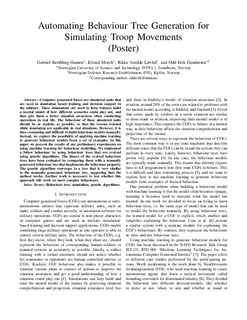Automating Behaviour Tree Generation for Simulating Troop Movements
Chapter
Accepted version
Permanent lenke
http://hdl.handle.net/11250/2645958Utgivelsesdato
2018Metadata
Vis full innførselSamlinger
Originalversjon
http://dx.doi.org/10.1109/COGSIMA.2018.8423978Sammendrag
Computer generated forces are simulated units that are used in simulation based training and decision support in the military. These simulations are used to help trainees build a mental model of how different scenarios could play out, and thus give them a better situation awareness when conducting operations in real life. The behaviour of these simulated units should be as realistic as possible, so that the lessons learned while simulating are applicable in real situations. However, it is time consuming and difficult to build behaviour models manually. Instead, we explore the possibility of applying machine learning to generate behaviour models from a set of examples. In this paper we present the results of our preliminary experiments on using machine learning for behaviour modelling. We implement a follow behaviour by using behaviour trees that are evolved using genetic algorithms. The fitness of the evolved behaviour trees have been evaluated by comparing them with a manually generated behaviour tree that implements the behaviour properly. The genetic algorithm converges to a tree that is very similar to the manually generated behaviour tree, suggesting that the method works. Further work is necessary to test whether this approach will work on more complex behaviours.
